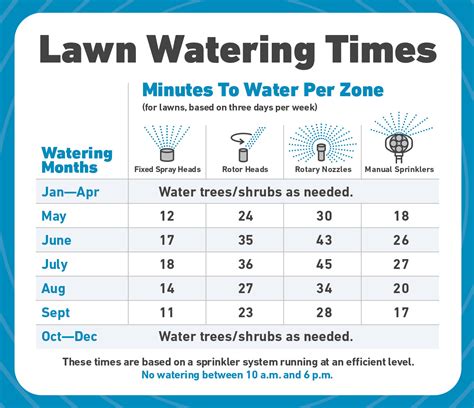How Long To Run Irrigation Zones
Ronan Farrow
Apr 06, 2025 · 3 min read

Table of Contents
How Long to Run Irrigation Zones: A Comprehensive Guide
Determining the ideal runtime for your irrigation zones is crucial for efficient water usage and healthy lawn maintenance. Overwatering leads to wasted resources and potential plant damage, while underwatering hinders growth and leaves your landscape vulnerable. This guide will help you determine the optimal runtime for your specific irrigation needs.
Understanding Your Irrigation System
Before diving into runtime calculations, familiarize yourself with your system's components. Knowing your sprinkler heads' type (rotary, spray, drip), spacing, and water pressure is essential for accurate estimations. Different sprinkler heads deliver water at varying rates.
Types of Sprinkler Heads and Their Water Distribution:
-
Rotary Sprinklers: These cover larger areas with a rotating spray, often used for open areas. They typically require longer runtimes but cover more ground efficiently.
-
Spray Sprinklers: Best for smaller, more defined areas. They offer a consistent spray pattern and usually need shorter runtimes than rotary sprinklers.
-
Drip Irrigation: This highly efficient method delivers water directly to the roots, minimizing water loss to evaporation. Drip systems require the most precise runtime adjustments, often varying by plant type and soil conditions.
Factors Affecting Irrigation Zone Runtime
Several factors significantly influence how long your irrigation zones should run. Failing to account for these could result in either overwatering or underwatering.
1. Soil Type:
- Sandy Soil: This drains quickly, requiring shorter, more frequent watering sessions.
- Clay Soil: Clay soils retain moisture longer, requiring longer intervals between watering and potentially shorter runtimes.
- Loam Soil: Loam, a mix of sand, silt, and clay, offers a good balance, usually requiring moderate runtimes.
2. Weather Conditions:
- Temperature: Higher temperatures lead to increased evaporation, requiring longer runtimes.
- Rainfall: Recent rainfall significantly reduces the need for irrigation. Check your local weather forecast before scheduling your irrigation system.
- Wind: Windy conditions can affect water distribution, potentially requiring adjustments to your runtime.
3. Plant Type and Maturity:
- Established Plants: Mature plants generally require less frequent and shorter watering compared to newly planted ones.
- Newly Planted Plants: Young plants need more frequent and longer watering to establish their root systems.
- Type of Plant: Different plant species have unique water requirements. Research the specific needs of your plants for optimal results.
4. Sprinkler Efficiency:
- Sprinkler Head Coverage: Overlapping spray patterns can lead to overwatering. Ensure proper sprinkler head spacing for optimal coverage.
- Water Pressure: Low water pressure might require longer runtimes to achieve adequate saturation, while high pressure can lead to runoff and wasted water.
Determining Your Optimal Runtime: The Test Method
The most reliable way to determine your optimal runtime is through a simple test.
- Choose a Zone: Select one representative zone.
- Place Cans: Place several evenly spaced empty cans within the zone's spray radius.
- Run the System: Run the zone for a set time (e.g., 30 minutes).
- Measure the Water: Measure the amount of water collected in each can. The most consistent amount indicates the average amount of water delivered across the zone.
- Adjust Accordingly: Based on the amount of water collected and the desired soil moisture level, adjust the runtime accordingly. Repeat this process as needed until you achieve optimal watering.
Maintaining Your Irrigation System for Efficiency
Regular maintenance is crucial for optimal runtime and efficient water usage. This includes:
- Regularly Inspecting Sprinkler Heads: Ensure they are not clogged or damaged.
- Checking for Leaks: Repair any leaks promptly to prevent water waste.
- Adjusting Sprinklers as Needed: Adjust sprinkler heads to ensure even water distribution throughout the zone.
By understanding these factors and implementing the suggested testing method, you can accurately determine the ideal runtime for your irrigation zones, ensuring a healthy landscape and conserving valuable water resources. Remember, consistent monitoring and adjustments are key to maintaining optimal irrigation efficiency.
Featured Posts
Also read the following articles
| Article Title | Date |
|---|---|
| How Long Is A Life Sentence In Nevada | Apr 06, 2025 |
| How Long Does Tricep Tendon Surgery Take | Apr 06, 2025 |
| How Long To Smoke Deer Bologna | Apr 06, 2025 |
| How Long Should You Take Sbi Protect Powder | Apr 06, 2025 |
| How Long Was 56 Weeks Ago | Apr 06, 2025 |
Latest Posts
-
How Many Subscribers Do You Need To Go To Vidcon
Apr 07, 2025
-
How Many Steps Are There For Intervention
Apr 07, 2025
-
How Many Steaks Come From One Cow
Apr 07, 2025
-
How Many Starburst In A 50 Oz Bag
Apr 07, 2025
-
How Many Stages Of Licenses Does Tadra Have
Apr 07, 2025
Thank you for visiting our website which covers about How Long To Run Irrigation Zones . We hope the information provided has been useful to you. Feel free to contact us if you have any questions or need further assistance. See you next time and don't miss to bookmark.
